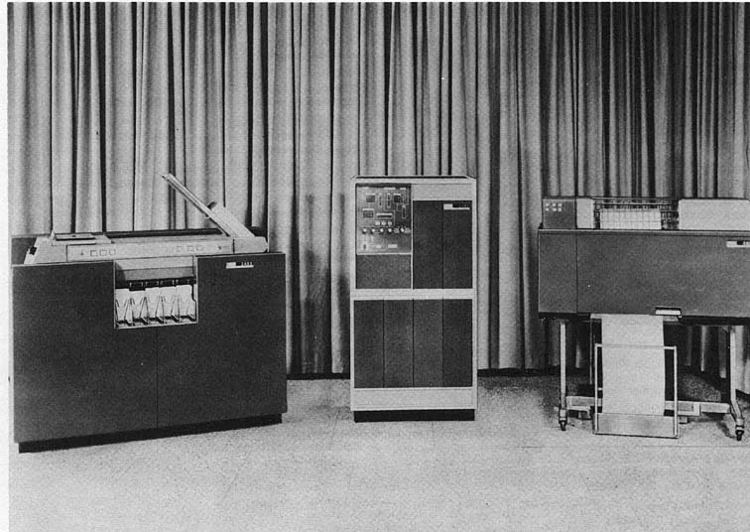 | ||
The IBM 1400 series were second-generation (transistor) mid-range business decimal computers that IBM marketed in the early 1960s. The 1400-series machines stored information in magnetic cores as variable length character strings separated at the left and right by a special flag, called word mark. Arithmetic was performed digit-by-digit. Input and output support included punched card, magnetic tape, and high speed line printers. Disk storage was also available.
Contents
Many members of the series could be used as independent systems, as extensions to IBM punched card equipment, or as auxiliary equipment to other computer systems. Some, however, were intended for specific applications or were economical only as independent systems.
History
The 1401 was the first member of the IBM 1400 series. It was the first computer to deploy over 10,000 units. The IBM 1410 was a similar design, but with a larger address space. The IBM 1460 was logically but not physically identical to a fully optioned 1401 with 16,000 characters of memory, and twice as fast. The 1240 was a banking system, equivalent to the 1440 system with MICR support. The IBM 7010 was logically but not physically identical to a 1410, and twice as fast.
Members of the 1400 series included:
Peripherals used with 1400 series machines included:
Compatible systems
IBM provided several models compatible (or nearly so) with the 1401.
Honeywell's Honeywell 200 provided approximate 1401 compatibility through a combination of architectural similarity and software support.
Field and character coding
With the 1410 series, the smallest addressable unit in core-storage is called character. The 1410 stores alphameric characters internally in binary-coded decimal (BCD) form, spanning 6 bits called BA8421. When the character is an operation code or is the first character in a field, another bit, called word mark, is included. An odd parity bit, called C, is also included.
Arithmetic is 10-based with the one's position at the high- and the most significant decimal digit at the low-address end of a multi-digit field, thus of ″big-endian″ style. This pertains for both, the (possibly indexed) address calculation for the access of operands and for the various operands of the arithmetic instructions. Whereas an address field in an instruction, designating an operand, is of fixed length (which depends on the size of the storage), the numeric operands of arithmetic instructions may be of arbitrary (positive) length. The word mark approach allows the 1410 to access a field (depending on the instruction to be performed) at either end, so that the most efficient access can be chosen. This way, the compiler of a higher level programming language has to take care of the initial increment of the operand address (by operand length minus 1) e. g. for add, subtract, or multiply instructions.
Programming languages
Programming languages for the 1400 series included Symbolic Programming System (SPS, an assembly language), Autocoder (assembly language), COBOL, FORTRAN, Report Program Generator (RPG), and FARGO.
Retirement
The 1400 series was replaced by System/360 and, later, by low-end machines like the IBM System/3, System/32, System/34, System/36, System/38, and AS/400.
The 1400s were officially withdrawn in the early 1970s, however some 1400-series peripherals were still marketed with third generation systems.
Two 1401 computers have been restored to full operational status at the Computer History Museum.
